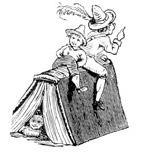
How Small Is Too Small?
GUEST COLUMN
Rumaisa and Hiba are the world’s smallest surviving twins. Born in 2004, Rumaisa set a Guinness world record for the all-time lowest birth weight of 9.2 ounces; her sister weighed in at a slightly heftier one pound, five ounces. Today, according to the physicians who wrote the girls’ case report in an article in Pediatrics, the official journal of the American Academy of Pediatrics (Dec. 12, 2011), both have normal motor and language development. Rumaisa and Hiba are also the two smallest surviving babies born in the U.S.
The present splendid functioning of the twins affirms the fact that, tiny as they were, these two little girls were indubitably human beings at least from birth. They were demonstrably viable at an exceedingly low birth weight. For some people (consider Planned Parenthood), viability is the criterion that determines the humanity of an unborn child. Rumaisa and Hiba, however, have not only advanced the frontiers of viability, but have raised, once again, the criterion of size. Can an unborn child be too small to be considered human? Is there a cutoff point at which any being is simply too small to be considered a living entity? The twins demonstrate their humanity by continuing toward maturity of body and getting larger. But would humans lose their humanity if they got smaller? The world of fiction has some interesting things to say on this point.
In Dr. Seuss’s children’s book Horton Hears a Who! (1954), Horton the Elephant hears a small speck of dust talking to him. The speck of dust is actually a minuscule planet populated by microscopic creatures known as “Whos.” Horton, thanks to his large elephant ears, is able to hear the “Mayor of the Whos” quite well and agrees to protect the Whos from harm. “After all,” Horton proclaims throughout the book, “a person’s a person, no matter how small.” The point here is more philosophical than biological. Size is relative, and it is prejudicial to assume that being too small is a disqualification for being a person.
In the movie Fantastic Voyage (1966), a surgical team is micro-miniaturized and injected through a hypodermic needle into a patient. The members of this Lilliputian team endure a harrowing odyssey as they maneuver to the location of the pathology, where they apply the needed therapy. The miniaturization process does not affect either their intellectual or physical capabilities. They are simply smaller, but no less effective and no less human. These courageous and competent “micro-biologists” finally make their exit from the patient, appropriately enough, through a teardrop which, from the patient’s viewpoint, seems to be a spontaneous expression of gratitude.
You May Also Enjoy
Neither Lewis nor Eliot was willing to condemn all uses of artificial contraception, yet both had obvious concerns about the moral implications of its use.
Infant mortality, life expectancy, and disability rates confirm that the poor and uninsured permanently suffer the consequences of our broken healthcare system.
Justice Ginsburg, a powerful abortion advocate, has been working for 20 years to reduce those populations she doesn't "want to have too many of."

